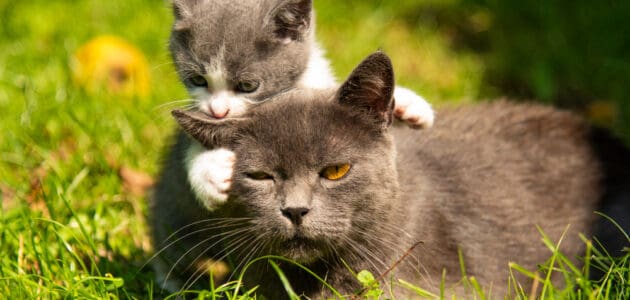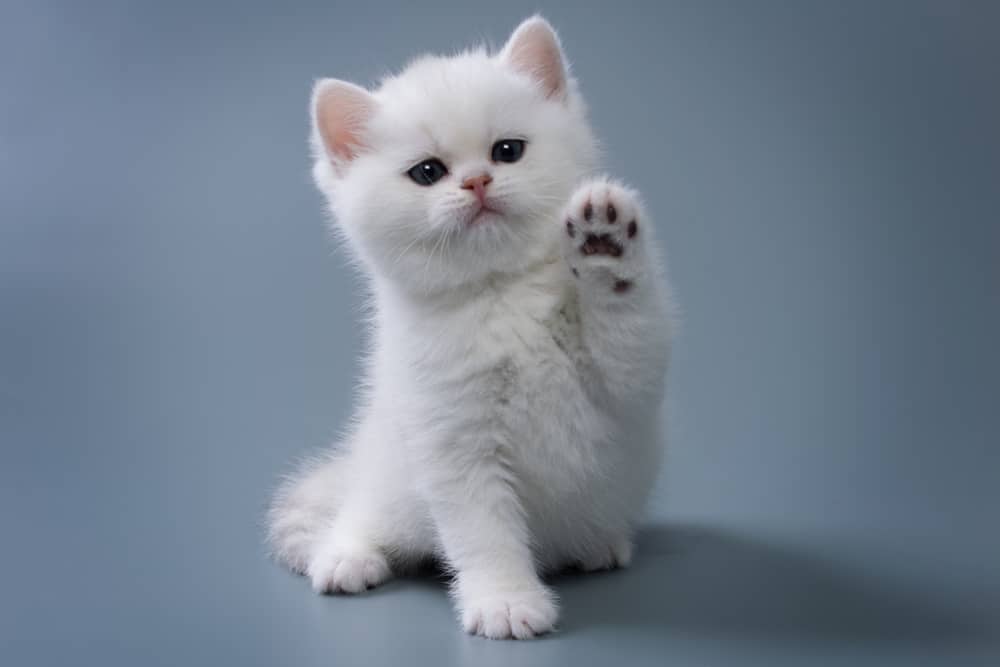How Big Will My Cat Get? Your Cat’s Growth Cycle

Whether you’re raising your cat from a kitten, or you’ve adopted a younger cat that is still growing, it’s likely that you’ve wondered exactly how big your furry friend will eventually become. Though there are a number of factors that can influence your cat’s size, it is usually not too hard to determine how big they will grow to be.
To help you understand your cat’s size, we’ve put together some of the most important information you need to know about a cat’s growth cycle, things that can affect your cat’s size, and some easy tricks to estimate the final size of your cat.
The Basics of Cat Growth
To understand just how big your cat will get, it is important to be informed about the factors that contribute to your cat’s size, maturity, and overall growth cycle.
What Affects Cat Growth?
There are several environmental and physical factors that can influence how big your cat will get.
Nutrition
Nutrition is one of the most important things to consider when estimating how large your cat will become. With proper nutrition, your cat will have the calories and energy they need to grow to their proper, natural weight and height.
However, if your kitten or cat is not receiving the right type of nutrition or they are receiving too many calories, they can turn out to be under or overweight. Check out this feeding guide for advice on how much you should be feeding your kitten or cat. You should also be sure to keep up with your pet’s changing dietary needs and move them from kitten to adult, and then to senior food, at the proper times in their life.
Genetics
The genetics of your cat play an integral part in determining how big your cat will grow. If your cat is a descendant of average-sized domestic shorthair cats, it is almost positive that they will be around the same size, barring any medical or nutritional issues. If your cat is a mixed breed and has some of the genetics of a larger cat, like a Ragdoll, a Siberian, or a Bengal, they could end up being heavier or taller than the average cat.
If you truly want to figure out your cat’s genetics to give you the best estimate of how big they will be, you can try out pet DNA testing to get to the bottom of your feline’s ancestry.
Spaying or Neutering
Spaying or neutering your cat, while necessary, can alter their growth if it is done too early (generally, before they are four months old). In both male and female cats, these procedures can change the hormones of your kitty, resulting in your cat unexpectedly gaining or losing weight, or not growing to their full size.
Keep in mind that reactions like this are somewhat rare and that the many health benefits of nurturing your cat outweigh the potential risks.
Medical Problems
There are medical conditions that your cat can come down with, like diabetes or a bone disorder, that may affect the normal growth of your cat. Issues like these will typically cause stunted growth, but they may sometimes cause weight gain. If you suspect that your cat is not growing normally, you should take them to see a veterinarian for a full examination to rule out any medical problems.

What Determines Cat Maturity?
In cats, full maturity is decided by three important things – reproductive ability, size, and social maturity. Your cat will reach each of these milestones at different times as they age; monitoring your cat as they grow is the best way to track their maturity and estimate exactly how big they will get.
Your Cat’s Growth Cycle
The cat’s growth cycle is full of changing needs and health requirements. Over the course of your cat’s life, and especially when they are young, you should stay up to date with these needs to ensure your cat grows up strong and healthy.
Kitten: Birth to 6 Months
A cat is classified as a kitten from the moment they are born until they reach 6 months old. During this stage, your kitten will experience rapid growth, so it is common to see them gaining weight and height quickly. At this stage, your cat will start to be socialized and will need lots of playtime and good nutrition to keep up their health.
As we’ll discuss below, you can weigh your kitten at 16 weeks old and double the number for a fairly accurate estimate of their final weight.
Junior: 6 Months to 2 Years
During the junior life stage, your cat will reach its full size and all of the milestones of maturity. Your cat should be reproductively mature between around 7 months to 1 year old, fully grown by a year old, and socially mature by the end of their 2nd year of life. Of course, when these milestones are reached depends on your cat and their environment, but most owners can expect their pet to be full-sized after they reach a year old. For a more in-depth answer to the question of when cats stop growing – check out this article.
Prime Adult: 3 to 6 Years
The prime adult stage is the time in your cat’s life where they are the most playful, energetic, and healthy. Cats like Ragdolls and Maine Coons that keep growing past a year will reach their full size during this stage—usually by the time they are 4 or 5 years old.
Mature Adult: 7 to 10 Years
Mature adult cats are starting to slow down. Many become more prone to illness during this time. It can be helpful to maintain a routine of regular check-ups with your vet to prevent or catch any kind of kitty aliment before it becomes serious.
Senior: 11 to 14 Years
Your senior kitty will likely sleep more and may end up losing weight, decreasing their size a little bit. However, if you notice your cat losing significant amounts of weight or refusing food and water, you should get them to a veterinarian as soon as possible.
During this stage of life your cat will need specialized nutrition to keep up with their changed metabolisms.
Super Senior: 15 and Older
Kitties that reach super senior status tend to spend most of their time cuddling up with their favorite human. If they were going to lose any weight, they would have done so during the previous life stage, and at this age, they are set to live out the rest of their days happily.
Figuring Out Your Cat’s Final Size
If you want an easy way to estimate your cat’s final size, you can try out any of these simple tricks.
Calculate It
One of the best ways to determine how big your cat will get is to weigh them once they are 16 weeks old. You can then take this number and double it; the result will give you a number that is a fairly accurate estimation of your cat’s final size.
Of course, this method won’t be possible if you adopted a cat older than 16 weeks, and it is not the best for determining how tall your cat will be.
Examine Their Back Legs
A quick check of your kitty’s back legs can give you an insight into their height. If your cat has especially long legs before they turn a year old, there is a good chance they will be quite tall. If their legs are on the shorter side, they may end up at an average or below average height.
Look at Their Family
If you happen to know the parents or older siblings of your cat, you can look to them for an estimation of how big your cat will get. The siblings especially are a great way to figure out how big your own cat will grow to. However, this method will be difficult if you adopted your cat from a rescue or elsewhere and don’t know where any of their older littermates are.
Average Cat Sizes
The average domestic short or long-haired cat will be between 9 and 10 inches tall, 18 inches long (without counting the tail), and weigh between 8 and 12 pounds. You can expect most cats to fall somewhere in this range unless they share the genetics of a breed that can grow bigger, such as a Ragdoll or a Maine Coon.
If you are concerned about your cat’s height or weight, or feel like they aren’t developing correctly, don’t hesitate to visit a veterinarian. They can help you determine if your cat is happy, healthy, and growing properly.

Lots of Love – No Matter the Size
In a caring environment, your cat should have no problem reaching a healthy, normal size and meeting all the milestones of cat growth, but to estimate their final size, you can always try out one of our tips. Be sure to keep an eye on your kitty to make sure they are receiving the nutrition and enrichment they need. And remember, no matter how big your cat gets, they will always need lots of love.




